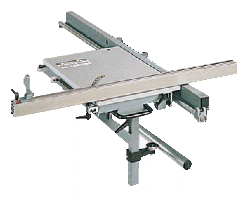|
|
|
Delta Sliding Table Review
| The
Realization After wasting a lot of time and energy building several versions of crosscut sleds I finally realized how inadequate these jigs are and I began a search for a sliding table to fit onto my saw. I looked at all those I could easily find on the market at that time (there are a couple more now) and finally decided upon the Delta unit. The primary reason for selecting the Delta is because of cost and I spent a lot of time inspecting one the local dealer had on the showroom floor. |
 |
| Delivery I ordered my slider from Amazon (TCON), the unit was on back order and took two or three weeks to arrive. I have noted that the price of this accessory varies quiet a bit over time even from the same supplier, shopping around will probably save some money. It appears to me that the unit Grizzly sells is identical except for the color; at the time I bought mine they were about the same price so I opted for the Delta since it matched my Unisaw color. The unit arrived via UPS in a big heavy box, the box was damaged a little but none of the parts inside were harmed and none were missing. Description Like all sliding tables, the Delta requires the removal of the left extension wing and the cutting or repositioning of the rip fence rail(s). I've read where some people have cut the rails instead of just shifting them, from my evaluation, none of the OEM or aftermarket rip fences need to be cut although one may choose to do so due to space requirements or because they just don't want to drill new holes to shift them. Assembly There isn't a lot of assembly involved and as far as the unit itself goes it is all pretty straightforward. On my example an attachment plate that is used to mount the vertical support to the carriage was welded up off-square a little. I shimmed one side so it would fit up better. The table board was also bowed down by about 1/16". The table board is made of laminated OSB and is not really as good as it needs to be. Since my table was bowed down it was easy to flatten it out by placing some shims between it and a part of the carriage. Aside from these issues the assembly was fairly uneventful. Alignment All sliding tables must be aligned when they are installed. Compared to others the Delta is slightly easier than most however none of the aftermarket sliding tables provide a very good means of achieving alignment without a bit of iteration. The good news is that sliding tables tend to hold their alignment for a long time. In the time I used the Delta I never had to realign it due to it drifting out of alignment on it's own. I did align it a few times due to the modifications I performed on it but I imagine this Delta unit in particular would hold an alignment indefinitely. While the instructions describe the assembly of the unit and its installation on a machine well, there isn't a lot of detailed information on how to perform an alignment. After a bit of fiddling around it becomes pretty obvious how to align the unit but it does take some time to perform if one hasn't done this before. There is a bit of an art to aligning a sliding table, I'm not aware of any sliding table supplier that demystifies this process, Delta certainly doesn't. At the end of the alignment process the slider needs to be:
Because of the weight of the guide bar and its support it is a
little difficult getting this piece installed in a position relative to the saw table.
This is what may cause some people problems. I eventually made modifications so that this
could be dialed in exactly. One thing that can't be "dialed in" exactly is
parallelism to the blade. If it doesn't bolt up to the table this way the mount would need
to be shimmed into alignment. Mine was right on so I didn't have any problem in this
regard.
While I was working on these main issues I went ahead and made a few more modifications to improve a some other aspects. To be clear, in the original state, the slider worked very well. The modifications listed above could have easily been designed into the unit by the manufacturer and it is a shame they did not. The additional modifications I performed transformed a good accessory into one that performed exceptionally well. |
|